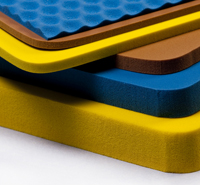Array of Flame Retardants Found in Baby Products
Baby products containing polyurethane foam — such as car seats, changing table pads, crib mattresses and nursing pillows — contain flame retardants that could pose health risks to children, a new study co-authored by a BU School of Public Health researcher has found.
The study in Environmental Science & Technology co-authored by Tom Webster, associate professor of environmental health at BUSPH, found that manufacturers of baby products have turned to other potentially dangerous flame retardants since the phase-out of a compound known as PentaBDE in 2004.
The research team collected 101 commonly used baby products and found that the most common flame retardant in use was a chlorinated organophosphate known as TDCPP. That compound was removed from use in children’s pajamas because of concerns that it could be toxic when absorbed.
The team also found several samples containing PBDE congeners that are closely associated with PentaBDE, “suggesting products with PentaBDE are still in use,” the authors said.
“To the authors’ knowledge, this is the first study to report on flame retardants in baby products,” the team said. “In addition, we have identified two chlorinated [flame retardants] not previously documented in the environment or in consumer products.”

Baby products containing polyurethane foam must meet California state furniture flammability standards, which affect the use of flame retardants in most such products. However, the authors said it was unclear to the public prior to the study which products contain flame retardants and at what concentrations. In all, 80 percent of the cushions used in car seats and other baby furnishings were found to contain chemical flame retardants that can accumulate in babies’ bodies.
“Based on exposure estimates conducted by the Consumer Product Safety Commission [CPSC], we predict that infants may receive greater exposure to TDCPP from these products, compared to the average child or adult from upholstered furniture, all of which are higher than acceptable daily intake levels of TDCPP set by the CPSC.”
The researchers said future studies are needed “to specifically measure infants’ exposure to these flame retardants from intimate contact with these products, and to determine if there are any associated health concerns.”
In 2006, the Consumer Product Safety Commission released a risk assessment of flame retardant chemicals, including TDCPP, in upholstered furniture foam. The report said that furniture manufactured with TDCPP-treated foam “might present a hazard to consumers, based on both cancer and non-cancer end points.”
The CPSC estimate of children’s exposure to TDCPP from treated furniture was five times higher than the agency’s acceptable daily intake, with most of the exposure from inhalation of the chemicals volatilized from treated furniture.
The new study, led by Heather Stapleton of the Nicholas School of the Environment at Duke University, used a portable X-ray fluorescence analyzer to estimate the bromine and chlorine content of the foam, in part to investigate whether the technique was a useful analysis tool for predicting the presence of flame retardant additives. The team found the analyzer was useful for detecting bromine, but had no significant correlation for chlorine.
Previous studies conducted at BUSPH have found that flame retardant additives can escape from products over time, accumulate in dust, and are a primary route of exposure to humans. Exposure for children is of particular concern, due to their frequent hand-to-mouth behavior, especially in products with which they are in close contact for long periods of time.
The authors urged further investigation into infant exposure to flame retardants in foam products, “particularly since infants are in a very sensitive development stage and may be more susceptible to adverse effects than an older child or adult.”
Submitted by Lisa Chedekel